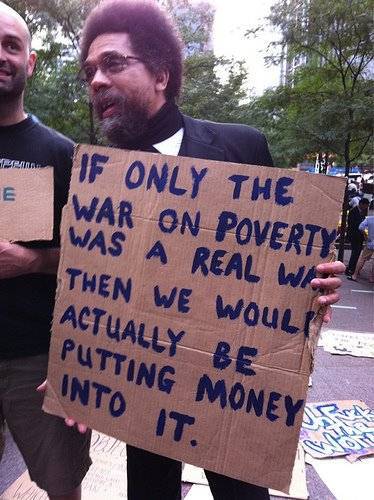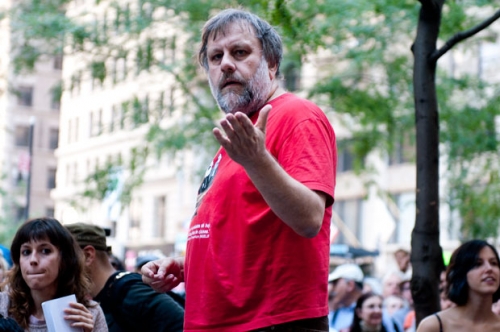Mic Check: how the Occupy movement is creating empathy through communication
Of the countless intersubjective graces unfolding in Zuccotti Park and around the Occupy world, the “human microphone” is recapturing something as old as human learning. This is something sacred: a repurposing of voice, ear, and content that may serve no less than the re-membering of a more coherent human consciousness.
Watch Slavoj Zizek to see how it works. Every Occupy Wall Street orator, prohibited by permit laws from amplification (and lights when night falls), stands on a box and delivers his sentences one at a time, each followed by a pause, during which the surrounding ring of listeners, perhaps 20 deep, repeats the sentence verbatim. The repeaters, unburdened by the anxiety of creation, actually improve the clarity of the orator’s rhythm and intonation as they fall into a shared pulse. Orators learn quickly that the sentences with thehighest torque are simple and well-metered – from the heartbeat of Zizek’s “They tell you we are dreamers”, to the rolling of “The marriage between democracy and Capitalism is over.” Michael Moore had to quickly drop his just-a-regular-guy banter, which in human-microphone-land makes him weak and self-deprecating. And Cornel West pulled the oration of Southern Baptism out of another decade and firmly jammed it into the hipster ears. Everyone speaks of spirit, and love. These are no longer ideas through this media but thrusts of embodiment that ripple through the group neurology.

Some orators attract so many listeners that multiple relay rings form spontaneously. This can slow down the oration up to fourfold, as each orbit of 20-deep repeats the sentence, and each ring forms a distinct choir: more men in this one, more women in that, a clear tenor back there, and a rowdier group who always wants to clap and cheer more than the rest. The centrifuge of sentiment and meaning extends to the horizon of the physical gathering, and then meets the threshold of the digisphere, where the Twitter birds listen and then fly. In Zuccotti Park, meaning starts with a heartbeat, and then it accelerates as it flies outward. But its plodding beginning forms a natural control upon the ego-inflation so easily amplified by electricity and then distorted beyond all embodied measure.
Richard Kim’s excellent Nation piece hits on the slow-speech angle beautifully: how it increases the spectacle impact, how it delays the revelation of the “manifesto” that cocaine-media is demanding (so its talking-heads can shred it on the altar of sound-bites), how it emasculates the Viagra-ed credit-default mainframes within the surrounding buildings of glass and steel. Here, I’d like to expand on Kim’s cogent introduction with some broader reflections on this communication revolution. My additions are about non-violent communication, embodiment, horizontality, spiritual renewal, and oral culture.

NVC
The Human Microphone is a naturally-occurring expression of non-violent communication, as per Rosenberg and others. It is based on the first principle: reflective listening. Nothing can move forward until the sentiment of the speaker is taken to heart (into the heart, as I’ll allude to later). The implicit premise is: you have not been heard until I offer your words back to you with the strength of my own voice.
Seeing our bodies together
The Human Microphone, as Kim points out, is grinding out the slowest-moving discourse we have seen in this generation. It took two weeks for the General Assembly to form an opening statement of intent. Slowness is crucial, not only because it resists the mechanized speed of tyranny, but because it de-emphasizes the conceptual realm, and places the body at the center of experience. The New York Times has finally laid off its conceptual demands, but up until a week ago, its writers displayed that profound discomfort – so common as to be invisible amongst our alienated intelligentsia – with a singular fact: bodies in the street that are saying many things, but no unified thing. Most importantly, bodies that stand their ground, and in standing, name the ground as their space. Bodies that drum out biorhythms instead of the disco of progress. In this slowness of embodiment we’re witnessing a staged amplification of every social awkwardness that occurs when our talking dries up. The dinner party with a pregnant pause that makes people squirm. The petering out of a water-cooler conversation. The subway squeezewhere our eyes can’t meet. We are watching the break in our conceptual flow that makes us instantly, claustrophobically aware that we are first and foremost these bodies that we spend our lives ignoring and abstracting. Bodies of shared needs and fears, bodies that Zizek implores us to honour to the bone: “Do not be afraid to truly want what you desire.”
No manifesto will contain theembodied energy of a paradigm change. But the body itself will feel it happen as it makes it happen in paroxysms of emotion and knowing gazes. Bodies on thestreet are crucial. Their silent witness is golden. Even their apparent incoherence on camera is a necessary chipping at the tyranny of our banal rationalism. And when brave young women are sprayed in the eyes with pepper, their bodies are microcosmic of the world we have made. They get blinded, temporarily, and we can all see very clearly, for the long term.
The horizontalization of power and teaching
The Human Microphone makes listeners participatory. Listeners instantly become teachers themselves. Nothing could be more empowering in a group setting. Knowledge or sentiment that passes fromspeaker to listener is no longer transactional, but transformational. The listener is initiated.
Internal transformation is implicit in this political theatre
It’s no mystery that there are powerful spiritualizing overtones ringing throughout the park. The content of coherence is dragged out of a medium of coherence. Speaking together is nurturing a yoga of sentiment that seems naturally given to shared value. We don’t have to agree on what the holy spirit means any more than we have to agree on a list of demands. Feeling the spirit and feeling its demands are what is most important, what has been longest suppressed or denied. Jesus doesn’t define “the poor” by income in the Sermon on the Mount: he’s not a policy wonk. He just uses the word, and lets it ring into the heart.
The Human Microphone regenerates the intimacy of oral culture
For the Buddhists, everything begins with “Thus have I heard.” Prior to mass literacy (which amplified interior complexity and created unlimited privatespace through the simple technology of the personally owned book), myth andknowledge were communicated chest-to-chest, in person, generally over food or other nourishment that coordinated physiological and conceptual digestion. What the Occupy speakers and listeners are doing is a return to this primal transmission, in which knowledge does not exist until it is shared, which, of course, poses an opposite paradigm to money. And in that sharing, the intersubjective blossoms: the speaker can hear plainly what resonates in the listener’s body and oral responses, and alter her course accordingly. Watch carefully what happens when Zizek throws his papers aside and makes continual eye contact with his first ring. He’s sweating and pulling his shirt away from his sternum – or is he continually tapping his heart?

This intimacy takes time, but it builds an incredible scaffolding of meaning. The original Buddhist canon was assembled in this call-and-response manner, with monks and nuns sitting in their rainy-season huts, remembering a verse, repeating a verse, all with that same patience that has allowed certain Brahmin families in India to memorize, generation by generation, the entirety of the Vedas. In old Indian culture, this is called shabda jnan: “knowing through sound.”
Oral culture naturally adds coolness and spaciousness to our passion
Not just in the McLuhan sense, although he would be quite impressed at thismost profitable regression from the tyranny of the visual. In ancient cultures, sound travels through the media of space and air. When we really hear our voices, things expand. The voice and the ear and the non-local magic in between them (for you can never tell exactly where sound is coming from), displaces the narrow aggressions of fire, which strafe the body of our culture through every pixel on every screen. The Occupy movement is not a visual movement – it has no coherent visual aesthetic, except the ironic icons of Guy Fawkes masks and homemade placards, and sheer embodied ebullience. They have humanized the visual space, their bodies filling the hard and arid streets. Their bodies are speaking and hearing, and we feel the individual, unique heat of every heart.
And it matters not that the future is unseen, for in the present, there is presence, and this can drive our dissociation away.
Special thanks to Michael Stone for inspiring this article.
You can read more of Matthew’s writing at: www.mathewremski.com


